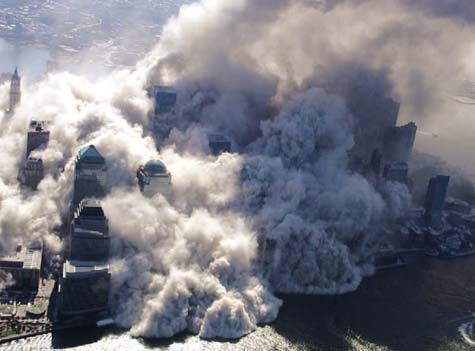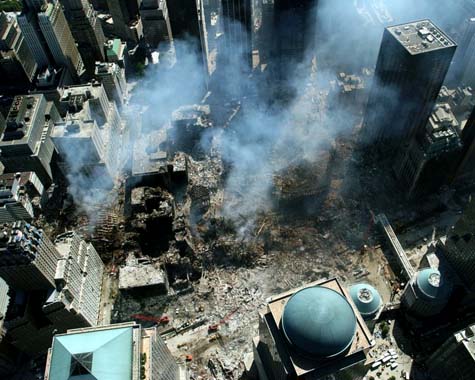 [Image: The South Tower of the World Trade Center on 9/11; photographer unknown].
[Image: The South Tower of the World Trade Center on 9/11; photographer unknown].On the flight over to Chicago last week I read an intense and frightening article in Discover about the wide range of post-9/11 illnesses that have begun to develop in New York City.
As most people no doubt know, tens upons tens – if not hundreds – of thousands of people literally inhaled the World Trade Center towers in the collapse and aftermath of 9/11.
It was the malign aerosolization of late modernist architecture, producing "the most dangerous atmospheric conditions ever to occur on American soil."
The "sky was glittering with glass" that day:
- A toxic cloud composed of industrial waste and human remains crept out from the aching, smoldering pit at Ground Zero and wound its way into the adjoining streets. Its vapors circled around and up buildings, pumped in and out of nostrils, mouths, and lungs, and stung the eyes of every woman, child, man, bird, and beast within a wide range. It spread itself on building walls and inside boiler rooms and left its trail on parked cars, handrails, and public benches. That day, New York City was blinded by a perpetually sickening haze. It poisoned the minds of politicians who acted with hubris and paranoia. It obscured the vision of responders and residents, many of whom acted with heroism and reckless bravado, never thinking that their actions might be endangering themselves, their families, their cities, and their very future. The cloud billowed southward, over the river, enveloping everything in the dust and debris of blown-apart lives.
Indeed, the "number of seriously ill New Yorkers could climb to 300,000 in the near future," and these serious illnesses run the gamut from "internal chemical burns" and "chronic respiratory and gastrointestinal conditions," many of which will be fatal, to "rare blood cancers" and asthma attacks.
 [Image: "Within a few hours’ time, a person exposed to the fumes could ingest toxins that would otherwise take a year to accumulate in a typical environment"; photographer unknown].
[Image: "Within a few hours’ time, a person exposed to the fumes could ingest toxins that would otherwise take a year to accumulate in a typical environment"; photographer unknown].None of which seems surprising when you read about what actually went up in the air that day:
- The Twin Towers contained tens of thousands of computer terminals, each housing about four pounds of lead, and an untold number of fluorescent bulbs that contained mercury. Released metal particles from the smoldering pit of the World Trade Center were so fine that they could easily slip past a paper face mask and reach deep into lung tissue, where they are poorly soluble in lung fluid. Metals and glass can remain trapped there for long periods of time and make their way into the heart.
 [Image: After the towers' collapse; photographer unknown].
[Image: After the towers' collapse; photographer unknown].After much more detail about both the "plume" itself and about the various environmental failures that occurred up and down the political chain of command, the article ends magnificently: "While the courts try to determine who is responsible for the environmental debacle following 9/11, countless New Yorkers continue to live and work near Lower Manhattan with the assumption that it is safe. The dust is now out of sight, out of mind, and possibly in their lungs, hearts, and bloodstreams."
So this is what happens when you pulverize and burn modern architecture: plumes of cadmium, thallium, benzene, silver, zinc, osmium, carbon monoxide, sulfuric acid, nickel, and lead drift outward into the city, snowing invisibly into local waterways, settling on windowsills and dusting the floors of homes, shops, and offices, salting food on plates at outdoor cafes, entering bloodstreams and sticking to clothes. Fiberglass and fire retardants, arsenic and rubber – asbestos, soot, and paper – all enter the atmosphere and form undetectable weather systems too vaporous and ghostlike to track.
Which leads me to wonder about what sort of post-bombardment aerial conditions existed in cities like Dresden or Hiroshima, after they were destroyed in World War II, when architecture was not made from such things – when there were not home computers and circuitboards to burn and when homes weren't full of flame retardant fabrics and PVC.
Were different and earlier forms of pulverized architecture somehow safer to breathe?
In fact, if I can be excused a brief moment of contextually inappropriate speculation, would it be possible to impregnate buildings with good things – with good chemicals: with vitamins and medicines and even seeds – so that future 9/11s release beneficial plumes and so that the inhalation of architectural smoke is no longer catastrophic?
Or would that just encourage terrorist attacks, arson, and urban warfare?
In any case, the article in Discover is well worth a half-hour or so of your time – especially if you lived or worked in lower Manhattan or Brooklyn during the weeks after 9/11.
No comments:
Post a Comment